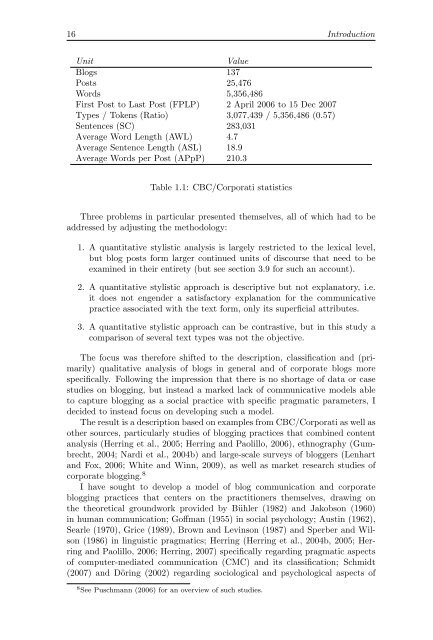The corporate blog as an emerging genre of computer ... - Oapen
The corporate blog as an emerging genre of computer ... - Oapen
The corporate blog as an emerging genre of computer ... - Oapen
You also want an ePaper? Increase the reach of your titles
YUMPU automatically turns print PDFs into web optimized ePapers that Google loves.
16 Introduction<br />
Unit Value<br />
Blogs 137<br />
Posts 25,476<br />
Words 5,356,486<br />
First Post to L<strong>as</strong>t Post (FPLP) 2 April 2006 to 15 Dec 2007<br />
Types / Tokens (Ratio) 3,077,439 / 5,356,486 (0.57)<br />
Sentences (SC) 283,031<br />
Average Word Length (AWL) 4.7<br />
Average Sentence Length (ASL) 18.9<br />
Average Words per Post (APpP) 210.3<br />
Table 1.1: CBC/Corporati statistics<br />
Three problems in particular presented themselves, all <strong>of</strong> which had to be<br />
addressed by adjusting the methodology:<br />
1. A qu<strong>an</strong>titative stylistic <strong>an</strong>alysis is largely restricted to the lexical level,<br />
but <strong>blog</strong> posts form larger continued units <strong>of</strong> discourse that need to be<br />
examined in their entirety (but see section 3.9 for such <strong>an</strong> account).<br />
2. A qu<strong>an</strong>titative stylistic approach is descriptive but not expl<strong>an</strong>atory, i.e.<br />
it does not engender a satisfactory expl<strong>an</strong>ation for the communicative<br />
practice <strong>as</strong>sociated with the text form, only its superficial attributes.<br />
3. A qu<strong>an</strong>titative stylistic approach c<strong>an</strong> be contr<strong>as</strong>tive, but in this study a<br />
comparison <strong>of</strong> several text types w<strong>as</strong> not the objective.<br />
<strong>The</strong> focus w<strong>as</strong> therefore shifted to the description, cl<strong>as</strong>sification <strong>an</strong>d (primarily)<br />
qualitative <strong>an</strong>alysis <strong>of</strong> <strong>blog</strong>s in general <strong>an</strong>d <strong>of</strong> <strong>corporate</strong> <strong>blog</strong>s more<br />
specifically. Following the impression that there is no shortage <strong>of</strong> data or c<strong>as</strong>e<br />
studies on <strong>blog</strong>ging, but instead a marked lack <strong>of</strong> communicative models able<br />
to capture <strong>blog</strong>ging <strong>as</strong> a social practice with specific pragmatic parameters, I<br />
decided to instead focus on developing such a model.<br />
<strong>The</strong> result is a description b<strong>as</strong>ed on examples from CBC/Corporati <strong>as</strong> well <strong>as</strong><br />
other sources, particularly studies <strong>of</strong> <strong>blog</strong>ging practices that combined content<br />
<strong>an</strong>alysis (Herring et al., 2005; Herring <strong>an</strong>d Paolillo, 2006), ethnography (Gumbrecht,<br />
2004; Nardi et al., 2004b) <strong>an</strong>d large-scale surveys <strong>of</strong> <strong>blog</strong>gers (Lenhart<br />
<strong>an</strong>d Fox, 2006; White <strong>an</strong>d Winn, 2009), <strong>as</strong> well <strong>as</strong> market research studies <strong>of</strong><br />
<strong>corporate</strong> <strong>blog</strong>ging. 8<br />
I have sought to develop a model <strong>of</strong> <strong>blog</strong> communication <strong>an</strong>d <strong>corporate</strong><br />
<strong>blog</strong>ging practices that centers on the practitioners themselves, drawing on<br />
the theoretical groundwork provided by Bühler (1982) <strong>an</strong>d Jakobson (1960)<br />
in hum<strong>an</strong> communication; G<strong>of</strong>fm<strong>an</strong> (1955) in social psychology; Austin (1962),<br />
Searle (1970), Grice (1989), Brown <strong>an</strong>d Levinson (1987) <strong>an</strong>d Sperber <strong>an</strong>d Wilson<br />
(1986) in linguistic pragmatics; Herring (Herring et al., 2004b, 2005; Herring<br />
<strong>an</strong>d Paolillo, 2006; Herring, 2007) specifically regarding pragmatic <strong>as</strong>pects<br />
<strong>of</strong> <strong>computer</strong>-mediated communication (CMC) <strong>an</strong>d its cl<strong>as</strong>sification; Schmidt<br />
(2007) <strong>an</strong>d Döring (2002) regarding sociological <strong>an</strong>d psychological <strong>as</strong>pects <strong>of</strong><br />
8 See Puschm<strong>an</strong>n (2006) for <strong>an</strong> overview <strong>of</strong> such studies.


